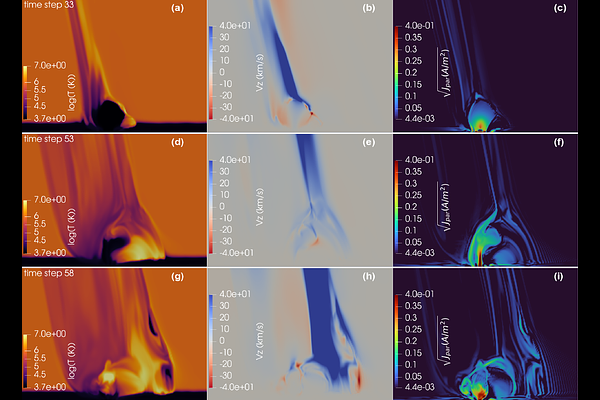Magnetic flux cancellation in a flux-emergence magnetohydrodynamics simulation of coronal hole eruptions and jets

Magnetic flux cancellation in a flux-emergence magnetohydrodynamics simulation of coronal hole eruptions and jets
Spiros Patsourakos, Vasilis Archontis
AbstractWe search for signatures of magnetic flux cancellation in a 3D resistive MHD flux-emergence simulation of coronal jets and eruptions in a coronal-hole-like environment. To do this, we analysed the output from a 3D MHD simulation of an emerging twisted horizontal flux tube from the convection zone into the solar atmosphere. The simulation considered the impact of neutral hydrogen on the magnetic induction equation, that is, it employed partially ionised plasma. Standard and blowout jets as well as eruptions were observed during the simulation. We observe clear evidence of magnetic flux cancellation in a short segment along the internal polarity-inversion line (iPIL) of the photospheric Bz during an extended period of the simulation characterised by eruptions and blowout jets. Converging magnetic footpoint motions at ~ 1 km/s carried sheared fields within the magnetic tails of the emerging flux tube towards the iPIL. These fields reconnect at the iPIL and generate concave-upward and slowly rising field lines causing a flux decrease that is associated with magnetic flux cancellation. We show evidence of magnetic flux cancellation in 3D MHD simulations of coronal hole eruptions and jets associated with an emerging twisted flux tube. The magnetic flux cancellation can be traced up to about 520 km above the photosphere and might contribute to the formation of pre-eruptive magnetic flux rope seeds. Although our results are consistent with several basic aspects of magnetic flux-cancellation observations associated with coronal jets, the observations nevertheless also suggest that cancellation involves much larger fractions of the available flux than our numerical simulation. We supply avenues to address this discrepancy in future work.